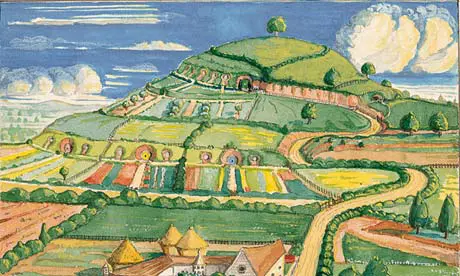The Many Traditions of Tolkien
From Front Porch Republic

Unlike The Lord of the Rings, J.R.R. Tolkien never finished The Silmarillion. He initially set out to write an epic mythology for England (with enough room that other minds could fill in the blanks), but later in life admitted the task was beyond him, going so far to call such an undertaking “absurd” (Tolkien’s Letters, 131, 180). He did produce a tremendous amount of histories, poems, metaphysical essays, forgeries of manuscripts in Old English, maps, annals, and more, but he consistently returned to make adjustments or add something new. Much like Niggle who, in Tolkien’s short story Leaf by Niggle, never managed to finish his painting of a tree before his journey, Tolkien left behind an incomplete masterpiece. But this incompleteness lends credibility to Tolkien’s mythology.
We are most familiar with his mythology as The Silmarillion, which Christopher Tolkien, his son and scholar in his own right, described as “a compilation, a compendious narrative, made long afterwards from sources of great diversity (poems, and annals, and oral tales) that had survived in agelong tradition.” Further, he wrote, “this conception has indeed its parallel in the actual history of the book, for a great deal of earlier prose and poetry does underlie it, and it is to some extent a compendium in fact and not only in theory.”
In the many retellings, Tolkien only ever finished one version of The Silmarillion’s narrative, and that was a summary of events. This is not even the version we are most familiar with: not the 1977 The Silmarillion published posthumously, but the Quenta Noldorinwa. The text is found in The Shaping of Middle-earth, the fourth volume of The Histories of Middle-earth series. In the Quenta Noldorinwa we find a prophecy of the end times, the Noldor as Gnomes, the Valar as Gods, and the Maiar as the children of the Valar, just to name a few changes from the 1977 The Silmarillion.
It is the broader set of texts available in The Histories of Middle-earth (along with some others) that Christopher Tolkien used to pull together The Silmarillion as published in 1977. Reflecting on the process, he wrote, “On my father’s death it fell to me to try to bring the work into publishable form. It became clear to me that to attempt to present, within the covers of a single book, the diversity of the materials–to show The Silmarillion as in truth a continuing and evolving creation extending over more than half a century–would in fact lead only to confusion and the submerging of what is essential. I set myself therefore to work out a single text. . .”
A wonderful text, indeed, and the most approachable version of the events of the First and Second ages, although it is incomplete in of itself. References to “Tol Eressea” go unexplained with answers found only in those broader works, and these answers lead us one after the other to the surprising discovery that Middle-earth is, in fact, our own world in ancient, ancient history.
We hear of a “Last Battle and the Day of Doom” in the 1977 The Silmarillion, but any further answers will not be found in that book. In other texts, we encounter this Last Battle again, and see J.R.R. Tolkien’s own details: the prophecy of Mandos concerning the end times. Now we receive that missing piece from The Silmarillion, that missing piece which every great mythology needs.
